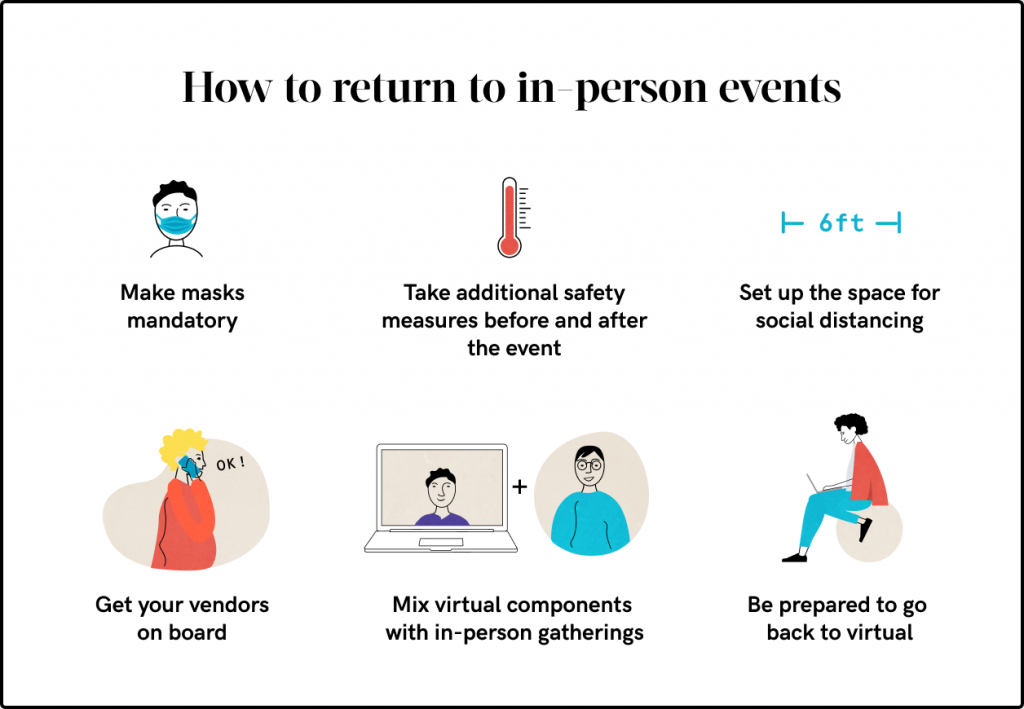How to Return to In-Person Events
After months of virtual meetings, classes, conferences, and happy hours, many of us are wondering when it will be safe to return to in-person events.
The answer? It’s complicated.
As much as we’d like to hit Ctrl + Z and return to a pre-COVID world, there still isn’t a clear understanding of what the outlook and recovery timeline will be for events. The safest way to host an event remains virtual. Once you start returning to in-person gatherings—even in small groups—the risk inevitably increases.
But some event planners are cautiously resuming in-person events and doing as much as possible to reduce the risks. If you’re considering going back to in-person events, or if you’re wondering what to expect when that time comes, here are tips on how to make the transition safely.

Make masks mandatory.
Wearing a mask is a lifesaver, not a political statement. Studies show that masks are effective in preventing the spread of COVID-19, so don’t forget to clearly communicate your event’s mask policy. You’ll also want to get acquainted with state and city ordinances that may require masks in public places.
On the day of your event, it’s a good idea to make masks (and plenty of hand sanitizer) available to attendees who need it or forgot theirs at home.
Take additional safety measures before and after the event.
Leading up to the event, it’s important for your staff to practice social distancing and monitor their symptoms. You’ll also want to continue these smart practices during and after your gathering: The CDC recommends conducting health checks of staff and attendees during events.
This will likely require additional training for your staff and some extra equipment, like contactless thermometers to take temperatures as guests arrive.
Set up the space for social distancing.
Spacing seats six feet apart is a start, but that’s only the beginning of setting up a socially distant event.
Refer to the CDC’s Daily/Weekly Readiness Assessment for events and gatherings. Make sure you’re taking every step possible to create a safe space, which includes:
- Using touchless payments
- Designating where attendees can stand in line with tape or chalk
- Using sneeze guards and partitions
- Avoiding shared materials (like pens), and sanitizing between uses
Get your vendors on board.
If your event requires coordination with vendors, talk to each vendor about your safety protocol ahead of time so that everybody comes prepared. Vet potential vendors by asking about their own precautions and protocols. Be sure your vendors are maintaining the same social distancing, symptom monitoring, and mask standards that you expect of your own staff and attendees.
Mix virtual components with in-person gatherings.
Hybrid events that combine face-to-face and online components are on the rise. These events are a great option when travel restrictions keep your whole group from getting together.
Regardless of where your attendees live, hybrid events are also a respectful option. Even if you feel ready to return to IRL events, your attendees might not be on board. Plus, you never know who has a compromised immune system or is caring for sick or elderly family members.
By creating opportunities for attendees to participate in-person or online, your event will be more inclusive.
Be prepared to go back to virtual.
For now, we are still living through a pandemic. As coronavirus cases surge in many parts of the world, there’s always a chance you’ll need to move your in-person event online at the last minute.
Even if cases aren’t on the rise near you, you may decide that a virtual event is the best option for your organization. With fewer logistics to consider and little to no risk of infection, online events remain the safest way to convene for the foreseeable future.
Looking for more virtual event resources? Head to our virtual event resources page.
This article originally appeared on theeventscalendar.com
Back to all posts